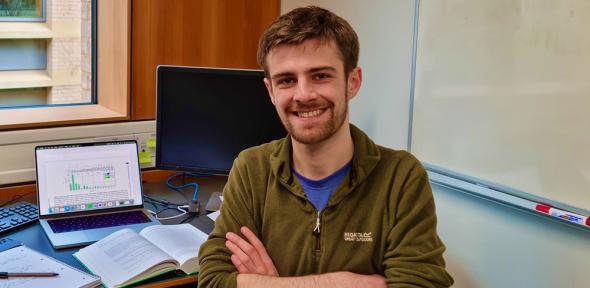
Joel Winterton is a first-year PhD student in the Department of Applied Mathematics and Theoretical Physics. After his undergraduate degree at the University of Manchester, he came to Cambridge in October 2023 to study the Part III master's course. He tells us about the joys of curiosity, how brain-tickling maths can help people, and the difference a Martingale Scholarship has made.
My research is in infectious disease dynamics. I'm exploring how diseases spread through human populations spatially, in particular, I study the impact of different patterns of human movement on disease transmission. I'm currently exploring when commuter movement (people traveling between home and work) adequately describes human mobility during an epidemic, and when it doesn't.
I've been able to do some cool projects during both my undergrad and Part III. One was in modelling influenza outbreaks in a boarding school (which is a favourite infectious disease example in Mathematical Biology textbooks), and another about automatically detecting brain lesions from an MRI scan. The main thing I’ve taken from both of these is that maths isn’t just something that tickles your brain, it can be used to create models that help people. I’ve found infectious diseases is a great field for this because you get to apply different topics from across many areas of maths to answer questions.
One of my favourite things I've done with maths was during my Part III project. I explored how models used in statistical physics to understand the behaviour of many-particle systems can be applied to automatically detect lesions on the brain from a 3D MRI scan.
This is because you can think of a pixel in an MRI scan as a particle that only affects particles nearby. Since human tissue isn't very patchy, if a pixel is surrounded by a certain type of brain tissue, it's more likely to be that type of tissue as well, rather than a different type of tissue. This means we can use the fact that pixels of the same tissue will cluster together spatially in the image to classify which pixels belong to which type of brain tissue.
My favourite thing about this was that, with a bit of creativity, maths from something totally different to the problem at hand can be used on really open questions to real life-problems (such as "how do we improve brain lesion diagnosis?").
My experience studying maths at Cambridge has been great! The Centre for Mathematical Sciences here is a very exciting place to be - there's tons of interesting people doing interesting maths. Given the opportunity, people love to tell you about what they're doing at the moment, and often this ends up with somebody rootling for a notebook and pen to show you a problem they're working on or explain a tricky concept. There's a great atmosphere of curiosity here; if you go into the CMS you're bound to see at least a few people looking very happily puzzled (sometimes at maths problems, sometimes at a cryptic crossword!).
Being a Martingale Scholar has meant I'm able to focus on doing the maths I enjoy. At every stage, from initially applying for Masters to doing my PhD, they’ve been really supportive and provided us with training days that complement the research skills we're developing. They've also provided opportunities to "get our hands dirty", such as a 4-day long programme called Solve for X, where we were split into teams to solve real world maths problems.
The Martingale Foundation provides fully-funded scholarships, as well as a development programme, to Masters and PhD students across STEM subjects. Find out more at https://martingale.foundation/.
You can hear from other participants of the Solve for X workshop in this edition of the podcast from plus.maths.org.
